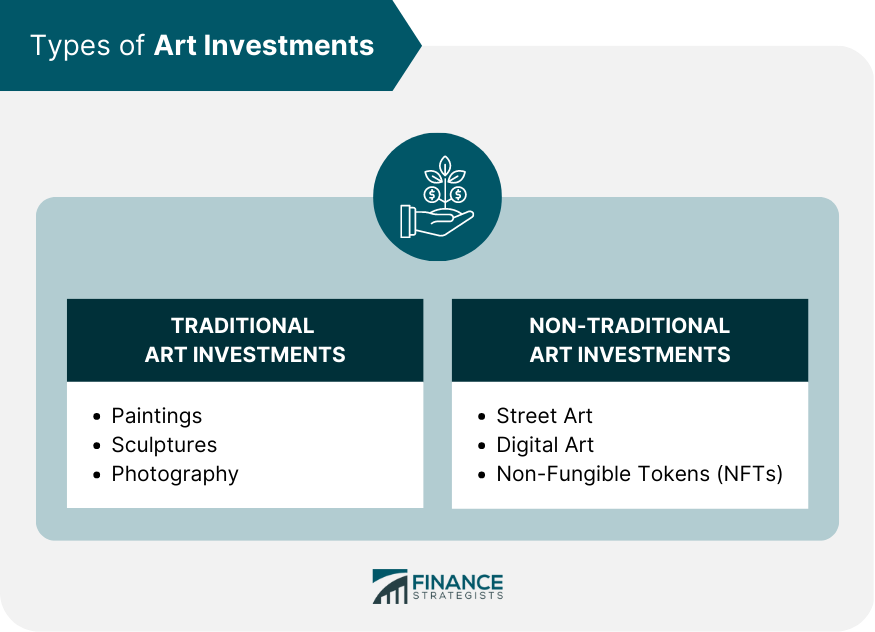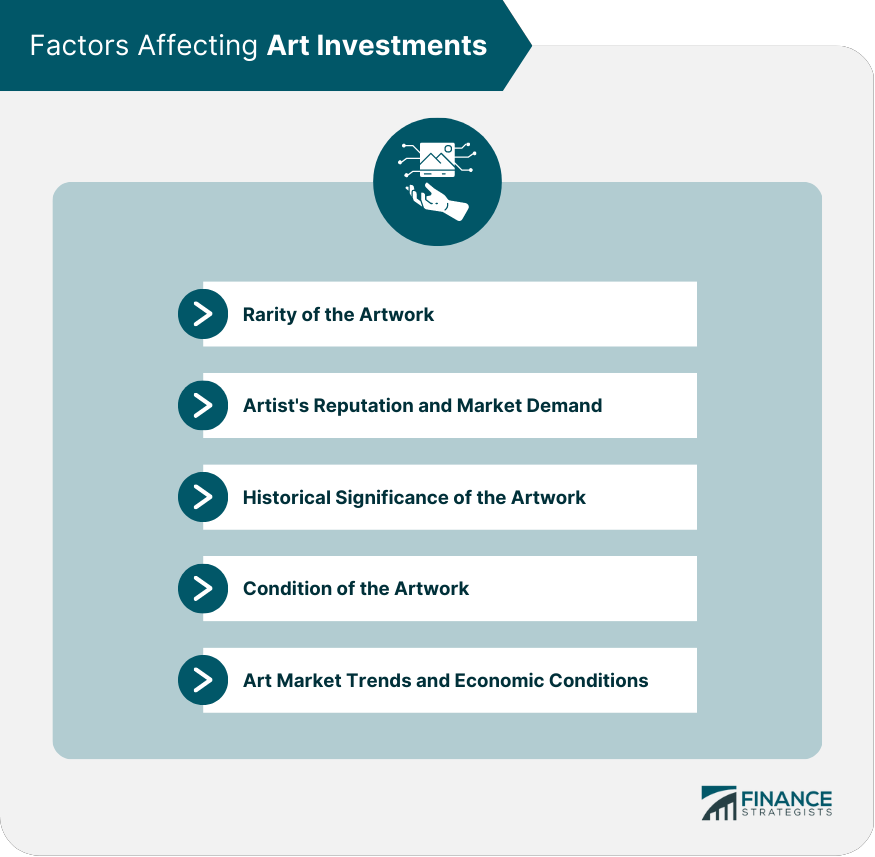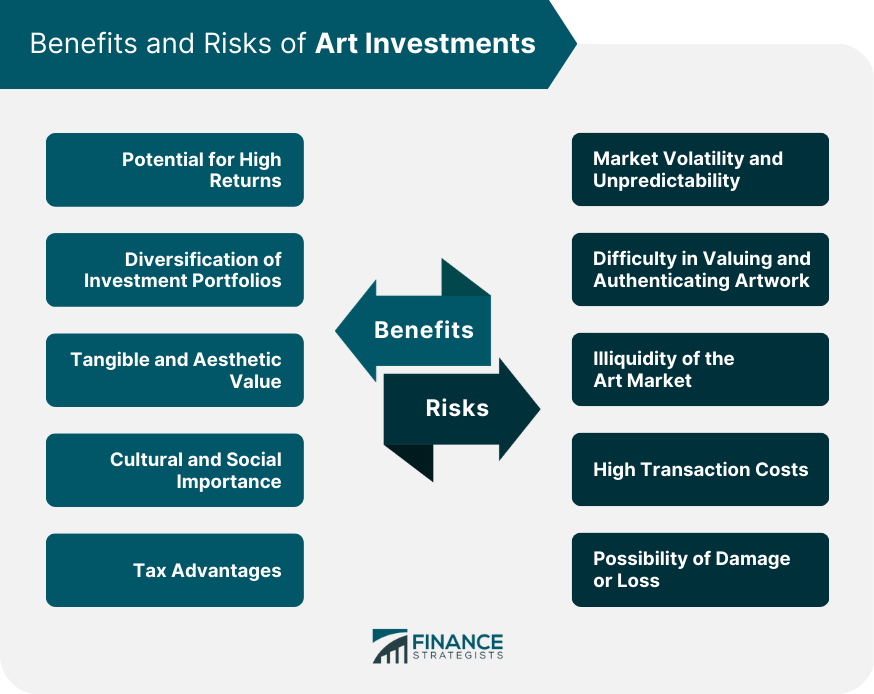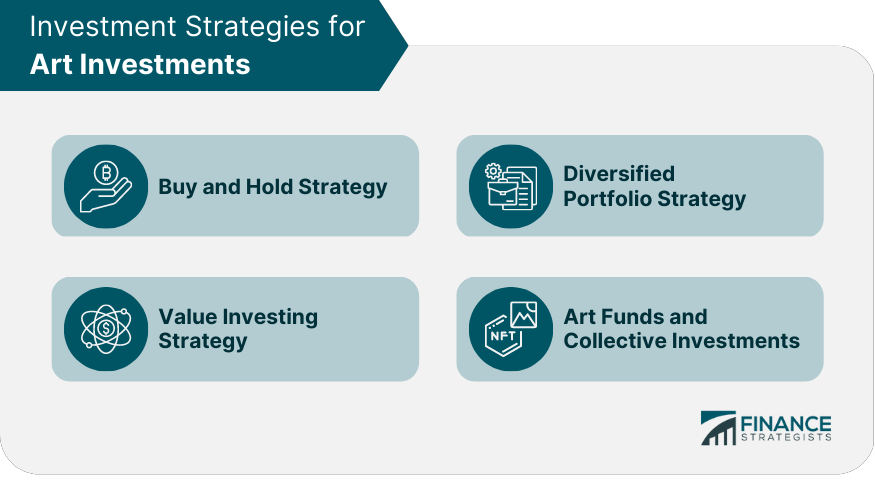Art investment refers to the buying and selling of artworks as a means of investing capital. It is a form of alternative investment that offers potential for high returns, diversification of investment portfolios, and cultural and aesthetic value. Art investments can take many forms, including traditional art such as paintings and sculptures, as well as non-traditional art such as street art, digital art, and NFTs. The value of an artwork can be influenced by several factors, such as its rarity, artist's reputation, historical significance, and market trends. While art investments can provide several benefits, they also come with risks and challenges, such as market volatility, difficulty in valuing and authenticating artwork, and illiquidity of the art market. Investing in art requires careful consideration and planning, and investors may use different investment strategies, such as buy and hold, diversified portfolio, value investing, and art funds and collective investments, to achieve their investment goals. Art investments come in many different forms. While paintings and sculptures are the most common types of art investments, there are several other non-traditional forms of art investments that have emerged in recent years. These investments are typically physical assets that are bought and sold at auction houses or through private dealers. Paintings are one of the most popular forms of art investments. They are typically bought and sold at auction houses or through private dealers. The value of a painting can vary depending on the artist, condition, historical significance, and rarity of the artwork. Sculptures are another form of traditional art investment. Like paintings, the value of sculptures can vary depending on the artist, condition, historical significance, and rarity of the artwork. Photography is a relatively new form of traditional art investment. The value of a photograph can vary depending on the photographer, condition, historical significance, and rarity of the artwork. Non-traditional art investments have emerged in recent years, with the rise of new technologies and art forms. Street art is a non-traditional form of art investment that has gained popularity in recent years. Street art is typically created on public walls and surfaces, and it can range from simple graffiti to complex murals. The value of street art can vary depending on the artist, condition, historical significance, and rarity of the artwork. Digital art is another non-traditional form of art investment that has emerged in recent years. Digital art can be created using various software tools, and it can be easily reproduced and distributed. The value of digital art can vary depending on the artist, condition, historical significance, and rarity of the artwork. NFTs or non-fungible tokens are a new form of art investment that has taken the world by storm. NFTs are unique digital assets that are verified on a blockchain. The value of an NFT can vary depending on the artist, rarity, and historical significance of the artwork. Several factors can influence the value of an artwork and its potential as an investment. The rarity of the artwork can have a significant impact on its value. Rare and unique artworks are often more valuable and sought after by collectors. The reputation of the artist and their market demand can also influence the value of the artwork. Well-known artists with a strong reputation and high demand can command high prices for their artwork. The historical significance of an artwork can also play a role in its value. Artworks that have a historical context or significance can be more valuable and sought after by collectors. The condition of the artwork is also an important factor in its value. Artworks that are in excellent condition are often more valuable than those that are damaged or in poor condition. Art market trends and economic conditions can also impact the value of art investments. The value of art investments can be influenced by changes in the economy and art market trends. Art prices may rise or fall based on changes in demand, supply, or market conditions. For instance, during economic downturns, art prices may decline as collectors may have less disposable income to invest in art. However, during times of economic prosperity, art prices may increase as demand for art investments may grow. Art investments offer several benefits to investors, including the potential for high returns, diversification of investment portfolios, and cultural and aesthetic value. Art investments can provide high returns to investors, with some artworks selling for millions of dollars at auction. While the returns on art investments can vary, some collectors have made substantial profits from investing in art. Investing in art can help diversify an investor's portfolio. As an alternative asset class, art investments can provide a hedge against market volatility, inflation, and economic downturns. Investing in art can also provide aesthetic and cultural value to investors. Artworks can be appreciated for their beauty, historical significance, or cultural importance, making them unique and tangible assets that can be enjoyed by their owners. Investing in art can also provide cultural and social benefits. By investing in art, investors can help preserve and promote art and cultural heritage. Artworks can also be used to support charitable causes or cultural institutions. Investing in art can also provide tax advantages to investors. In some countries, art investments may be exempt from certain taxes, such as capital gains tax, inheritance tax, or value-added tax (VAT). However, the tax treatment of art investments can vary depending on the jurisdiction, so it is important to consult with a tax professional before investing in art. While art investments can provide several benefits to investors, they also come with risks that should be carefully considered before investing. The art market can be volatile and unpredictable, with prices fluctuating based on demand, supply, and market conditions. It can be challenging to predict the future value of an artwork, and investors may face losses if the value of their art investment declines. Valuing and authenticating artwork can be challenging, especially for non-experts. The value of an artwork can vary depending on several factors, such as its condition, rarity, and historical significance. Authenticating an artwork can also be challenging, as some artworks may be forged or misrepresented. The art market can be illiquid, meaning that it may be challenging to sell an artwork quickly or at a fair price. The value of an artwork can also be influenced by factors such as its provenance, condition, and authenticity, which can make it challenging to find a buyer for an artwork. Investing in art can also be costly, with high transaction costs associated with buying and selling artworks. These costs can include auction fees, commissions, insurance, storage, and transportation. Artworks can be fragile and vulnerable to damage or loss, which can negatively impact their value. Art investors may need to take measures to protect their investments, such as insuring their artwork, storing them in secure facilities, and handling them with care. Investing in art requires careful consideration and planning. Here are some investment strategies that investors may consider when investing in art. The buy and hold strategy involves purchasing an artwork and holding onto it for an extended period, with the expectation that its value will appreciate over time. This strategy requires patience and a long-term investment horizon, as the value of an artwork may take years or even decades to appreciate. The diversified portfolio strategy involves investing in a variety of artworks to reduce the risk of losses. By diversifying their art investments, investors can spread their risk across different artists, styles, and mediums. The value investing strategy involves purchasing undervalued artworks with the potential for future appreciation. This strategy requires careful analysis of market trends, historical sales data, and the artist's reputation to identify undervalued artworks. Art funds and collective investments are a type of investment vehicle that pools funds from multiple investors to invest in art. These investment vehicles can provide access to a diverse range of artworks and may be managed by experienced art investors. Art investment involves the buying and selling of artworks as a means of investing capital. It is recommended to work with wealth management services to assess the risks and opportunities of art investments and to develop a sound investment strategy that aligns with the investor's financial goals.What Are Art Investments?
Types of Art Investments
Traditional Art Investments
Paintings
Sculptures
Photography
Non-Traditional Art Investments
Street Art
Digital Art
Non-Fungible Tokens (NFTs)

Factors Affecting Art Investments
Rarity of the Artwork
Artist's Reputation and Market Demand
Historical Significance of the Artwork
Condition of the Artwork
Art Market Trends and Economic Conditions

Benefits of Art Investments
Potential for High Returns
Diversification of Investment Portfolios
Tangible and Aesthetic Value
Cultural and Social Importance
Tax Advantages
Risks of Art Investments
Market Volatility and Unpredictability
Difficulty in Valuing and Authenticating Artwork
Illiquidity of the Art Market
High Transaction Costs
Possibility of Damage or Loss

Investment Strategies for Art Investments
Buy and Hold Strategy
Diversified Portfolio Strategy
Value Investing Strategy
Art Funds and Collective Investments

Conclusion
While traditional art forms such as paintings, sculptures, and photography have long been popular among investors, non-traditional forms such as street art, digital art, and NFTs have gained popularity in recent years.
The value of an artwork can be influenced by several factors such as its rarity, artist's reputation, historical significance, and market trends.
Art investments offer several benefits, including the potential for high returns, diversification of investment portfolios, cultural and aesthetic value, and tax advantages.
However, they also come with risks such as market volatility, difficulty in valuing and authenticating artwork, illiquidity of the art market, high transaction costs, and the possibility of damage or loss.
Investors may use different investment strategies such as buy and hold, diversified portfolio, value investing, art funds, and collective investments to achieve their investment goals.
Investing in art requires careful consideration and planning, and investors should be prepared to do their due diligence to make informed decisions.
Art Investments FAQs
Art investments refer to the buying and selling of artworks as a means of investing capital. It is a form of alternative investment that offers potential for high returns, diversification of investment portfolios, and cultural and aesthetic value.
Art investments offer several benefits to investors, including the potential for high returns, diversification of investment portfolios, and cultural and aesthetic value. Investing in art can also provide cultural and social benefits and may offer tax advantages in some countries.
While art investments can provide several benefits, they also come with risks and challenges, such as market volatility, difficulty in valuing and authenticating artwork, illiquidity of the art market, high transaction costs, and the possibility of damage or loss.
Investment strategies for art investments include buy and hold, diversified portfolio, value investing, and art funds and collective investments. These strategies require careful consideration and planning to achieve investment goals.
The value of an artwork can be influenced by several factors, such as its rarity, artist's reputation, historical significance, and market trends. Valuing and authenticating artwork can be challenging, especially for non-experts. It is recommended to work with a professional art appraiser or art investment expert to assess the value of an artwork before making an investment.
True Tamplin is a published author, public speaker, CEO of UpDigital, and founder of Finance Strategists.
True is a Certified Educator in Personal Finance (CEPF®), author of The Handy Financial Ratios Guide, a member of the Society for Advancing Business Editing and Writing, contributes to his financial education site, Finance Strategists, and has spoken to various financial communities such as the CFA Institute, as well as university students like his Alma mater, Biola University, where he received a bachelor of science in business and data analytics.
To learn more about True, visit his personal website or view his author profiles on Amazon, Nasdaq and Forbes.











